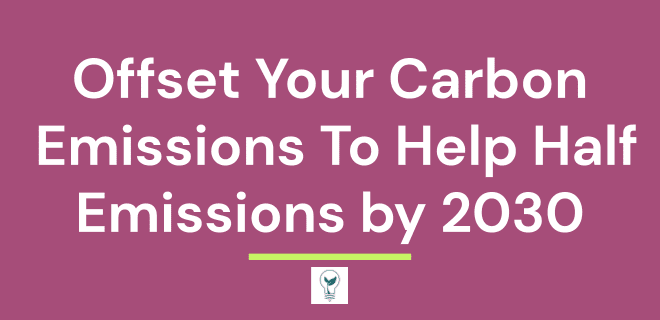Here we look at; What Is a Carbon Footprint; Calculating Your Carbon Footprint; and How to Offset Your Carbon Emissions. This is one of over 40 ideas in our Sustainability Roadmap with Solutions to Climate Change, and part of our series on Growing, Eating, and Living Sustainably.
Update to this post [4th August 2022]: I now use the amazing mobile app called CoGo to automatically track then offset my carbon emissions. CoGo links to your banks and credit cards to automatically track your carbon emissions based on where you spend and how much you spend. At the end of each month you can then choose and pay for projects from South Pole to offset your previous month’s carbon emissions. Emission reduction projects can generate “ex ante” (certificates are issued before the emission reduction) or “ex post” (certificates are issued after the emission reduction) certificates. Over 99% of the emission credits from South Pole’s portfolio come from “ex-post” climate protection projects, where the climate impact is verified and calculated before the certificates are issued. You can learn more and download CoGo from the App Store or Play Store.
If you already know that you want to reduce your greenhouse gas emissions to do your part to help climate change, here are the options to offset your emissions:
If you want some more facts before making any decisions, let’s get into the details:
Unfortunately, we’ve been dependent on fossil fuels.
Part of being dependent on fossil fuels is because of the lies and misinformation from the fossil fuel industry that knew the effects of burning fossil fuels as long ago as the 1970s. There’s a great video short on WaterBear that explain those lies:
I also heard, just in the last month, in one of the Drilled podcasts (The ABCs of Big Oil | Ep 2. Elementary School) that fossil fuel companies have been creating music, activities, coloring books, comic books, movies, and more to shape how American kids think about society, the economy, and the environment. That’s been happening since the 1920s! Fossil fuel companies also targeted kids in elementary school: You can read more about it in this article on The ABCs of Big Oil: The Fossil Fuel Industry’s Century-Long Quest to Invade Elementary Schools—be prepared to be incredibly angry at the thought of big oil creating propaganda to brainwash children and continue to damage our planet and our future, just for the sake of profit!
No wonder the majority of us kept on buying and burning fossil fuels, without any thought about the damaging effects to the planet, our lives, and the future of humanity.
Thanks to the latest IPCC report on climate change, we finally have confirmation from the global scientific community that the climate crisis is ‘unequivocally’ caused by human activities.
So, we’ve been dependent on fossil fuels, which means we regularly emit some sort of greenhouse gas into the atmosphere.
It’s important that we transition away from fossil fuels as quickly as possible if we’re to achieve the next deadline of halving global emissions by 2030.
Switching to a green and renewable energy provider is an excellent way to reduce your carbon footprint. Finding ways to conserve energy, such as turning off your central heating boiler in summer, will also help to reduce your emissions.
But, we need to do more than reduce our emissions. We need to 0 our emissions!
So, based on the global targets that have been set to avoid irreparable damage to our planet and the climate that we need to survive, we have to go from 6.5 tons per person per year (as the average, you can work out your own actual carbon footprint next) to 3.25 tons per person per year by 2030 then 0 tons by 2050!
But why do we need to halve emissions by 2030 then reduce down to 0 tons by 2050? Find some more information on this in our article on How To Sustain Life On Our Planet.
What Is a Carbon Footprint?
A carbon footprint is the amount of carbon and greenhouse gases that each of us emit in our lives.
The obvious one is driving a car that uses petrol or diesel, or using gas and electricity (unless you’ve already switched to green and renewable energy), but there are lots of other things in our lives that create greenhouse gas emissions: Buying food and drink, books and magazines, computers, mobile phones; taking the bus or train; flying somewhere…
Reducing our carbon footprint to 0 is the goal, but it can be difficult to do that immediately. While you’re working towards that goal, you can offset your carbon emissions.
Calculating Your Carbon Footprint
Knowing your carbon footprint is a great place to start. There are lots of carbon footprint calculators on the internet. I use the calculator by a company called Carbon Footprint.
Here’s the Carbon Footprint Calculator
It’s important to remember that CO2 is not the only greenhouse gas. There are other greenhouse gasses that are significantly worse than CO2, such as Nitrous Oxide and Methane. For this reason the calculator takes into account all greenhouse gases that include CO2, N2O, and methane etc. You can learn about the methodology that the calculator uses.
How to Offset Your Carbon Emissions
The Carbon Footprint calculator makes it super simple to pick suitable carbon offset projects, based on your carbon footprint.
I did this to offset the emissions from our car.
When I purchased the carbon offset I based it on 20,000 miles a year in a Subaru diesel. We now own a Mitsubishi Outlander hybrid so our emissions have dropped significantly, however, based on 20,000 miles a year in the Subaru the carbon offset cost £90, which I thought was a fantastic price.
I chose the UK Tree Planting project because I could have trees planted in The Midlands, with my son’s school listed as one of the planting locations. This project also comes with Plant a Tree – Protect a Tree: For every tree that you pledge, a tonne of carbon will also be saved in the Brazilian Amazon via Carbon Footprint’s VCS avoided deforestation programme. This meant I could offset our carbon as well as planting and protecting forests and biodiversity in 2 continents.
There Are a Lot of Carbon Offset Projects to Choose from, Such As:
- Malawi Biomass Conservation
- Borehole Rehabilitation Project in Uganda
- UK Tree Planting + Brazil Reducing Deforestation
- Rwanda Borehole Clean Drinking Water
- Wind Based Power Generation By Panama Wind Energy
- Dachunhe Sanji 6MW Hydropower Project
- Kocaeli Landfill Gas to Electricity Project
- Negros Island Solar Power
- Nanyang Danjiang River Solar Cooker Project
- Plus a LOT more projects to choose from
You can find out more about all of the carbon offset projects.
Reducing emissions is a big topic that I’ll come back to again and again. I hope this was a helpful introduction to finding out your carbon footprint then looking at ways to offset and reduce your emissions.
Here Is What You Can Do
- Find out your carbon footprint
- Try the Sustainability Roadmap
- Check out #VoteWithOurMoney
- Use the Company Directory
- Be inspired. We can live climate positive
- Talk to your friends and colleagues
- Share this with others
Where Next?
There is so much inspiring information to give you ideas of how to help climate change by growing, eating, and living sustainably, you can:
- Read Our Articles
- Sign-Up to Our Free Email Newsletter
- Get Started and Vote with Your Money
- Try the Sustainability Roadmap
- Use the Company Directory
- Support Nafford Junction
Sources Used to Create This
- carbonfootprint.com – Calculate
- Episode 2: Climate Denial: 50 Years of Lies & Misinformation
- The ABCs of Big Oil | Ep 2: Elementary School
- AR6 Climate Change 2021 – Sixth Assessment Report
- The ABCs of Big Oil: The Fossil Fuel Industry’s Century-Long Quest to Invade Elementary Schools
- How to Switch to a Green Energy Supplier
- Turn off your gas boiler in summer to help climate change
- How To Sustain Life On Our Planet
- carbonfootprint.com – UK Tree Planting
Production Notes
This was produced by me, James Walters, as a personal project to help stop climate change by inspiring others to grow, eat, and live sustainably.
Any advice given is the opinion of those involved and does not constitute medical, financial, or legal advice.
* We include links we think you will find useful. If you buy through those links, we may earn a small commission. It’s one way to support our work and to inspire as many people as possible.

